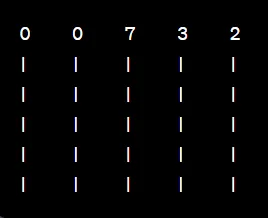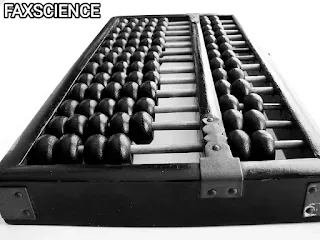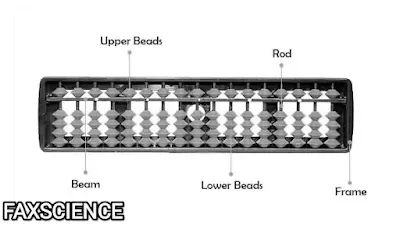WHAT IS AN ABACUS ?
An Abacus is an ancient
tool used to study mathematics over all around the world. It is defined as a counting instrument used by sliding counters along rods or troughs to perform numerical operations. The abacus, also known as the abacus, is a counting instrument that has been used since ancient times. It was used in ancient times in the Near East, Europe, China and Russia. It
is used for basic algebraic mathematical calculations like addition,
subtraction, multiplication and division. Additionally, abacus can also be used
to find the square and cubic values of any whole number.
An abacus is called अबेकस in Hindi. In this article I am going to share all the information about an Abacus like its description, its history, its working and much more.
DOES IT EVEN HAS A HISTORY ?
The abacus is one of the oldest known
calculating tools, with a history dating back thousands of years. Its exact
origins are uncertain, but it is believed to have been invented by the Sumerians
in ancient Mesopotamia around 2400 BCE. The earliest abacuses were made from
sand or dust on flat surfaces and used simple grooves for counting. As trade
and civilizations spread, the abacus evolved and was adopted by various
cultures, including the Egyptians, Greeks, Romans, and Chinese. Each culture
developed its own version of the abacus, with varying designs and methods of
calculation.
The Chinese abacus, known as the
suanpan, is one of the most well-known and widely used variations. It appeared
around the 2nd century BCE during the Han Dynasty and is still in use in some
regions of Asia today. The suanpan typically consists of a rectangular frame
with rods or wires, each containing a series of beads that can be moved to
perform calculations. During the Middle Ages, the abacus continued to be an
essential tool for merchants, traders, and scholars in Europe and the Islamic
world. With the introduction of Arabic numerals and the adoption of more
advanced mathematical techniques, the abacus became even more relevant in
aiding complex calculations.
With the advent of mechanical
calculators in the 19th and 20th centuries, the popularity of the abacus
declined in many parts of the world. However, it still remains a valuable
educational tool for teaching mathematical concepts, and in some cultures, it
holds traditional and symbolic significance. In recent times, the abacus has
experienced a revival as an educational aid to develop mental arithmetic skills
and enhance brain development, especially in early childhood education. Its
enduring legacy continues to inspire fascination with the ancient roots of
mathematics and human ingenuity.
HOW EXACTLY DOES AN ABACUS WORKS ?
Let’s take an example - Let's say we have a simple abacus with 5 rows of beads, and each row has 5 beads. Here's how it works:
1. Representing Numbers: The abacus can represent
numbers from 1 to 9,999. For now, we will only focus on smaller numbers to keep
it simple.
2. Place Value: Each row of beads on the
abacus has a specific value, just like numbers have place values (ones, tens,
hundreds, etc.). Starting from the right side, the rows have the following
place values: ones, tens, hundreds, thousands, and ten-thousands.
3. Example: Let's represent the
number 732 on the abacus. To do this, we'll position the beads accordingly:
-
Move 2 beads on the thousands row to the left.
-
Move 3 beads on the hundreds row to the right.
-
Move 2 beads on the tens row to the right.
The abacus should now look
like this:
 |
| WORKING OF ABACUS |
4. Reading the Number: To read the number on
the abacus, simply count the beads on each row. In our example, it's 732.
5. Adding Numbers: If we want to add
numbers, we can move the beads to represent the numbers we want to add and then
count the beads to get the result. Similarly, for subtraction, we move beads in
the opposite direction to represent the numbers and then count the remaining
beads to get the result.
6. Why It's Helpful: The abacus helps us
visualize and understand numbers better. It's like having a colourful and
tactile calculator!
So, the abacus is a fun and useful
tool for doing math, especially for young kids who are learning about numbers
and arithmetic.
ADVANTAGES OF AN ABACUS
There are
several advantages for the kids who use abacus while studying and plays with
it. Scientific Research had been conducted on the kids who use abacus, the
results were pretty shocking and it shows the following improvements and
impacts on the brain:
1.
Improves thinking
2.
Improves observation and attention
3.
Improves vision and imagination
4.
One of the benefits of the abacus is
that it improves memory
5.
Increase speed and accuracy
6.
Enhance creativity
7.
Increase self-confidence
8.
Strong learning foundation
9.
Reduce stress
10. Developing
all driving skills
11. Develops
the ability to analyze, one of the main benefits of the abacus
DIFFERENT VARIETIES OF ABACUS
In the past their have many types of abacuses
in our world, each had unique look and design but many of the perished while
some managed to survive. Here the list of the notable ones:
· Chinese Abacus (Suanpan): The suanpan is the most
well-known type of abacus, originating in ancient China. It consists of a
rectangular frame with two decks of rods or wires. The upper deck usually has
two beads on each rod, representing the value of five, while the lower deck has
five beads on each rod, representing the values one to four. The suanpan is
widely used in Chinese culture and is still employed in some Asian countries.
· Japanese Abacus (Soroban): The soroban is a
variation of the Chinese suanpan and is used in Japan. It features a
rectangular frame with an odd number of rods on the upper deck and an even
number of rods on the lower deck. Each rod on the upper deck has one bead,
representing the value five, while each rod on the lower deck has four beads,
representing the values one to four. The soroban is popular in Japanese schools
and is considered an essential tool for mental arithmetic training.
· Russian Abacus (Schoty): The schoty is a
traditional abacus used in Russia and other Slavic countries. It has a
rectangular frame with ten vertical rods and one bead on each rod. The schoty
is a simple and efficient tool for performing basic calculations and remains
part of Russian cultural heritage.
· Nepalese Abacus (Soroban): In Nepal, a soroban-like
abacus is used for arithmetic calculations. It is similar to the Japanese
soroban but might have variations in the number of rods and beads.
· Western Abacus: The Western abacus, also
known as the "Greek" or "Roman" abacus, was used in ancient
Greece and Rome. It had a flat surface with carved grooves or lines, and small
stones or counters were placed in the grooves to perform calculations.
· Indian Abacus: The Indian abacus, also
called the "Darshanika" or "Kak-koori," is a traditional
calculating tool used in ancient India. It consists of a wooden frame with two
decks of rods, and pebbles or seeds are used as counting objects.
· Salamis Tablet: The Salamis Tablet was an
ancient Greek abacus-like device, made of bronze or marble, with carved lines
and shallow holes for performing calculations.
MODERN-TIME ABACUS
While in the prime time of the abacus,
it was in a great use. It is still in use as it helps to teach the basics and
fundamentals of mathematics and arithmetic to the children in all over the world.
The Japanese designed Abacus “Soroban” has been in use for several ages for the
calculations of multi-digit numbers and still in use today. As it serves as an instrument
with which children can study and at the same time play, indirectly and directly
affecting and improving their maths grasping abilities.
CONCLUSION
In conclusion, the abacus is an
ancient and easy-to-use counting instrument that has played an important role
in the development of mathematics throughout history. Its origins can be traced
back to various civilizations, including the Sumerians, Indians, Egyptians,
Greeks, Romans, and Chinese. The abacus has evolved over time, with different
cultures creating their unique versions of this calculating tool. Despite the
advent of modern calculators and digital technology, the abacus remains
relevant, especially as an educational aid for teaching arithmetic and
improving mental math skills in children. Scientific research has shown that
using the abacus can have several positive effects on brain development,
memory, attention, and creativity in young learners.
Different types of abacuses, such as the Chinese suanpan, the Japanese soroban, the Indian abacus, the Russian schoty, and others, have been used in different parts of the world. Each type has its distinct design and methods of calculation. While the abacus might not be as widely used for day-to-day calculations in modern times, its enduring legacy continues to be appreciated in educational settings and as a symbol of human ingenuity in the development of mathematics. It serves as a testament to the creativity and practicality of ancient civilizations and their contributions to the advancement of human knowledge. The abacus remains an invaluable tool for understanding numerical concepts and fostering a strong foundation in mathematics for generations to come.
REFERENCES
Here is the list of websites, I recommend you to view as they have tons of useful information that I haven’t included, information of different types of Abacuses will be provided here:
THANK YOU !!! FOR THE READING TILL LAST AND I HOPE YOU ALL LIKED IT & DON'T FORGET TO SHARE THE ARTICLE!!!



